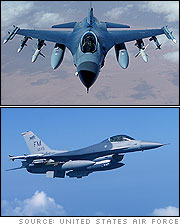Fighter Planes: Lockheed Martin F-16

The world's most popular fighter plane
by David Noland
 Lockheed Martin F-16 Specs
Related Links |
The F-16—officially called the Fighting Falcon, but known as the Viper among its pilots—is the world's most popular fighter plane. More than 4,400 have been built for the air forces of 25 countries. Small, simple, and relatively cheap, the F-16 has a number of technological breakthroughs that have made it the world's Top Gun for almost three decades.
The F-16 grew out of the lessons of Vietnam, where America's hulking twin-engine F-4 Phantom fighters were badly outmaneuvered by lighter, more agile Russian-built MiG-21s. The prototype YF-16 first flew in 1974, and won a fly-off with the Northrop YF-17 to be the Air Force's new air-combat fighter. The F-16 joined the USAF in 1979, and is still this country's front-line fighter plane, with more than 1,500 operational today. The Air Force took delivery of its last F-16 in 2005.
"Fly-by-Wire" Control System
The F-16's most innovative design feature is its "fly-by-wire" control system, the first on any aircraft. In a normal plane, the pilot moves a control wheel or stick connected to the plane's elevator, ailerons, and rudder. But in the F-16, a computer moves the control surfaces in response to electronic input from the pilot's control stick.
This innovation allowed the F-16 to be designed with negative stability, which makes it more maneuverable. An unstable aircraft is normally difficult or impossible for a human pilot to keep under control. But the F-16's quadruple-redundant fly-by-wire computer automatically makes constant split-second corrections to keep the plane stable.
Phenomenal Maneuverability
The F-16 is designed to maneuver at up to nine g's. This allows it to turn tighter than other fighters, a big advantage in a dogfight. But at such high g-loadings, the pilot is crushed down into his seat by almost a ton of force, and can barely lift a finger. So the F-16 has a small side-mounted control stick on an armrest. Instead of moving back and forth, the F-16's fixed joystick responds to hand pressure. In a tight, high-g turn, an otherwise immobilized F-16 pilot can literally fly with the twitch of a finger.
Aerodynamics also help the F-16's maneuverability. Wing-body strakes along the nose generate vortexes, small whirling tornadoes of air that flow back across the wings. The resulting "vortex lift" helps keep the F-16 wing from stalling at the high angles of attack required for extreme maneuvering.
Originally designed and built by General Dynamics, the F-16 and its Ft. Worth assembly plant were sold to Lockheed in 1993. Lockeed then merged with Martin in 1995.








